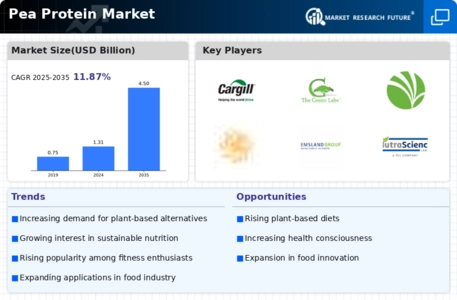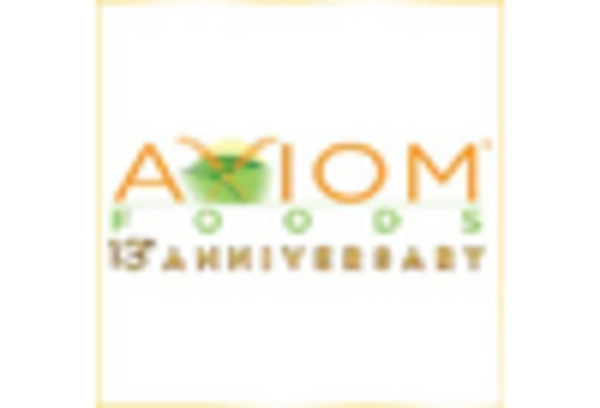Growth of Vegan and Vegetarian Diets
The rise in the adoption of vegan and vegetarian diets is likely to significantly influence the Pea Protein Market. As more individuals choose to eliminate animal products from their diets, the demand for plant-based protein sources has intensified. Pea protein, being a versatile ingredient, is increasingly incorporated into various food products, including meat alternatives, protein bars, and dairy substitutes. Market analysis shows that the meat substitute segment, which prominently features pea protein, is expected to witness substantial growth, potentially exceeding USD 5 billion by 2026. This shift in dietary preferences indicates a robust opportunity for the Pea Protein Market to expand its reach and cater to a growing consumer base.
Sustainability and Ethical Consumerism
Sustainability concerns and ethical consumerism are becoming pivotal drivers for the Pea Protein Market. As consumers become more environmentally conscious, they are increasingly seeking products that align with their values. Pea protein, derived from legumes, is considered a more sustainable protein source compared to traditional animal proteins, as it requires less water and land for production. This shift towards sustainable eating habits is reflected in market trends, with a notable increase in the sales of plant-based products. The Pea Protein Market stands to benefit from this growing demand for sustainable food options, as consumers prioritize products that contribute to environmental preservation.
Expansion of E-commerce and Online Retail
The expansion of e-commerce and online retail channels is likely to play a crucial role in the growth of the Pea Protein Market. With the increasing reliance on online shopping, consumers are more inclined to explore and purchase plant-based protein products through digital platforms. This trend is supported by the convenience and accessibility that e-commerce offers, allowing consumers to discover a wider range of pea protein products than what is typically available in physical stores. Market data indicates that online sales of health and wellness products, including pea protein, are expected to grow significantly in the coming years. This shift towards online retail presents a substantial opportunity for the Pea Protein Market to enhance its distribution and reach a broader audience.
Innovative Applications in Food and Beverage
The Pea Protein Market is experiencing a surge in innovative applications within the food and beverage sector. Manufacturers are increasingly exploring new formulations that incorporate pea protein into a variety of products, ranging from snacks to beverages. This innovation is driven by consumer demand for functional foods that offer health benefits, such as improved muscle recovery and satiety. Recent market data suggests that the protein-enriched beverage segment is projected to grow significantly, with pea protein being a key ingredient. This trend indicates that the Pea Protein Market is not only adapting to consumer preferences but also expanding its product offerings to meet diverse dietary needs.
Health Consciousness and Nutritional Benefits
The increasing awareness of health and nutrition among consumers appears to be a primary driver for the Pea Protein Market. As individuals seek healthier dietary options, the demand for plant-based proteins, particularly pea protein, has surged. Pea protein is recognized for its high protein content, essential amino acids, and low allergenic potential, making it an attractive alternative to animal-based proteins. Market data indicates that the plant-based protein segment is projected to grow at a compound annual growth rate of over 7% in the coming years. This trend suggests that consumers are gravitating towards products that not only meet their dietary needs but also align with their health goals, thereby propelling the Pea Protein Market forward.

















